Reader's Choice
Popular articles
Marking porcelain was used almost from the very beginning of its production in ancient China. Initially, it was used to designate the manufacturer, but pretty soon the marking was also used to protect against counterfeit.
Marking was done by applying special stamps. The stamp of each manufacturer is unique - it is a kind of brand name. In Europe, the label began to be used since 1723. Gradually, the branding of porcelain products became more widespread. As a rule, blue paints were used for this. At first they were applied to the already fixed glaze, but rather soon they began to carry out marking with an underglaze method.
For a long time, the question of labeling products remained at the discretion of the manufacturer. Only from the end of the 18th century the placement of tags on porcelain became a requirement. Certain standards were introduced regarding the very execution of the stigma. Thus, porcelain manufacturers were obliged to register their trademarks, passing for this special procedure. In Russia, chinaware has been labeled since 1745. The first stamp was carried out by order of Gunter on a cup made by the Imperial Porcelain Factory. Interestingly, the label contained information not only about the place, but also about the time of manufacture of the cup. It is believed that the official history of Russian porcelain began with this label.
In the Czech Republic, the stamps used for chinaware have not been full-fledged brand names for a long time. So, in order to indicate the origin of the product, several letters were originally inscribed on it. These letters were a reduction of porcelain manufacturing places or the names of the owners of the respective manufactories.
Sometimes in order to emphasize the geographical affiliation of a product, the word “Austria” was added to the abbreviations. After 1918, it was replaced by the phrase "Made in Czechoslovakia." Also at the bottom of the china was abbreviation EPIAG. In 1945, the composition of the label changed again - now the word “Germany” began to be added to the sign of the manufactory or factory. Finally, after 1945, manufacturers of porcelain tableware returned to the use of old stamps designed for Czech manufactories.
Thus, the history of Czech porcelain branding was closely connected with the history of the country itself. Since chinaware was one of the most valuable export goods, the regulation of its production, as well as protection against forgeries with the help of stamps, was carried out literally at the state level.
In the 18th century, European porcelain manufactories were faced with the emergence of a huge number of fakes. Protecting shop interests, manufacturers were forced to improve their brands.
Initially, labels were applied to porcelain with resistant paint on top of the already fixed glaze. As practice has shown, this method was ineffective, and the signs were easily forged. As a result, they began to carry out branding, applying blue paint before glazing. Pretty soon there were fakes and such tags. As a result, in 1827, metal stamps were used for marking. In manufacturing plants, the marks were placed on unfired porcelain using metal stamps or seals. This work was done by the molders themselves.
Interestingly, the struggle of European manufactures with fakes during this period was side by side with the falsification of porcelain by the manufacturers themselves. Thus, some European manufactories used stigma-hieroglyphs, giving out their products as oriental china.
Currently, two types of tags are most common.
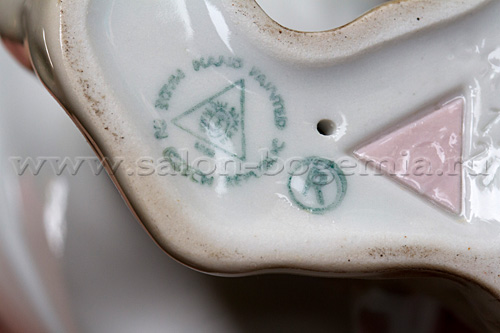
In order to ascertain the authenticity of porcelain, it is necessary to carefully examine the stamp. If it is made with paint, then the label must be under the glaze. The stamp must be even and neat, not chipped, defective or damaged. Today, there are whole registries of stamps, which allow to determine by the label on the porcelain product of its manufacturer, as well as, in some cases, the period of manufacture. At the same time, you shouldn’t focus only on labels - it is also important to evaluate the quality of the pattern, the shape of the product, the quality of the porcelain itself.
In the "Salon of Bohemia" you can from the leading factories. All products have trademarks, as well as documents confirming their origin.
Choosing jewelry from precious metal to buy a fake product, made not from gold and silver - what could be more offensive? In addition to disappointment, buying a “jewel” skillfully disguised as an adornment with a really high cost will bring a loss of money. How to avoid cheating?
The most reliable way to control the authenticity of jewelry in Russia is to check the presence of two stamps on them: an imprint of the state assay inspection and the name of the manufacturer.
The imprint of a state assay inspection, often also referred to as “breakdown”, is a brand that is put on gold and silver jewelry. The presence of such a mark on the product indicates that the ring, earrings or pendant are legally sold in Russia - the sale of products made of precious metals, on which there is no print, is prohibited in the territory of the Russian Federation.
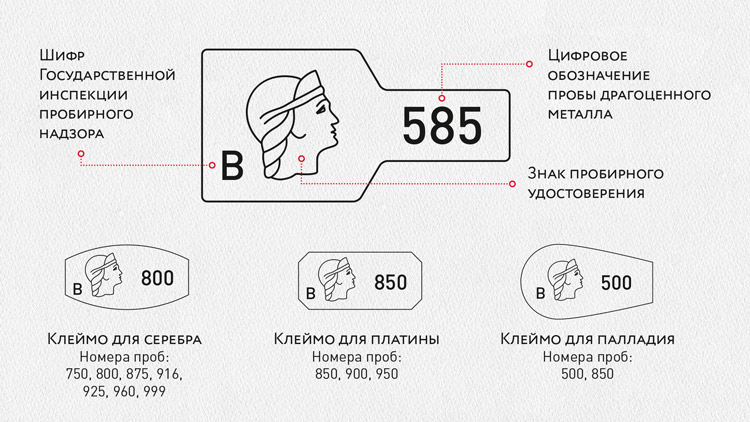
The stamp of the state assay inspection consists of several parts. Elements of the impression are enclosed in the general contour: the head of the girl in the kokoshnik looking to the right, the code of the state inspection of the assay supervision, located at the bottom left relative to the image, the digital code indicating the quantitative content of pure gold in the jewelry alloy. The code of the state inspection of assay supervision allows you to find out where the decoration was tested.
The general contour in which the parts of the stamp are enclosed must be different depending on what precious metal the product is made of. Thus, the mark is encircled by a contour, resembling a spatula, of silver — an oval cut to the right and left, of platinum — an octagon stretched horizontally.
If among the old jewelry you have found a product with a stigma that depicts a star, do not be alarmed - such articles were used to mark items made of precious metal during the USSR. The shape of the contour for the types of metal in Russia remained unchanged.
On complex jewelry, which are not directly connected to each other, there is another, additional stamp. It is a digital cipher for the content of pure precious metal and is applied, for example, to studs - after all, parts of the lock of this type of earrings are detachable.
“Name-maker of the manufacturer” is the second stamp, the presence of which on a piece of jewelry is necessary. It is a kind of analogue tag on clothing and contains information about the manufacturer. Deciphering the print, you can get the most complete information about the purchased jewelry.
![]()
The stamp “nominal” is a four-digit alphabetic cipher enclosed in a single contour. It is rectangular in shape and, as a rule, is applied next to the “breakdown”.
The imprint contains four letters. The first will indicate the year when the product was produced (for example, “H” - 2012, “O” - 2013, “P” - 2014). The second one will indicate the code of the state assay body of Russia where the product was inspected (for example, “B” - Upper Volzhskaya). The last two letters are the individual code of the manufacturer, which cannot be repeated within one inspection.
By the imprint of the manufacturer in case of doubt in the decoration, you can find out when, where and by whom the decoration you bought was released.
To ensure the authenticity of the jewelry before buying it in the store, it is important to check the presence of stamps on it. You should arm yourself with a magnifying glass: to preserve the aesthetic appearance, they are made small, and information on them can only be distinguished with a magnifying tool.
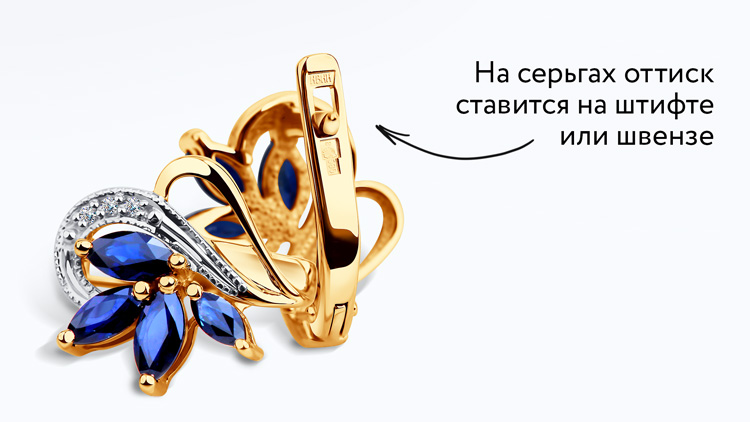
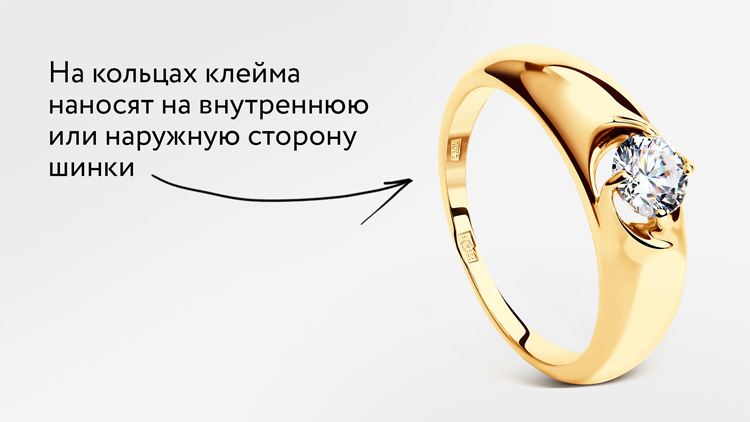
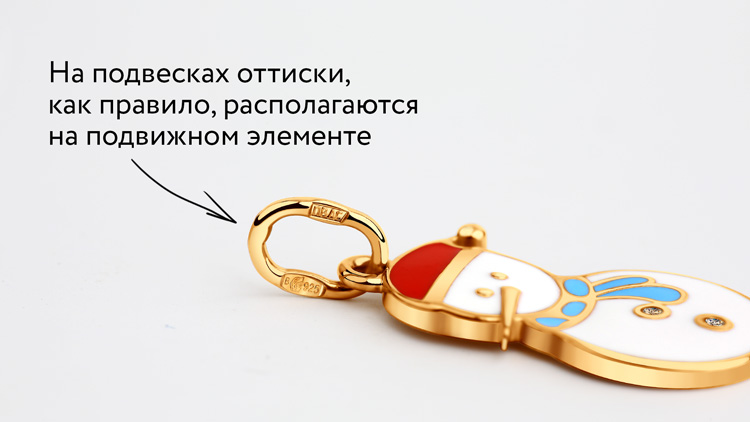
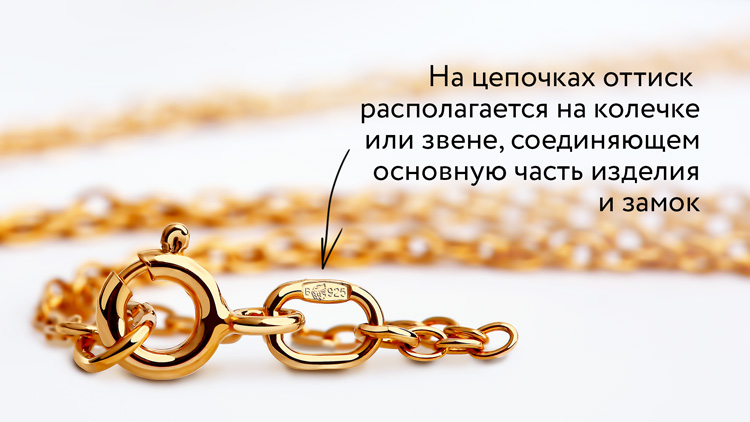
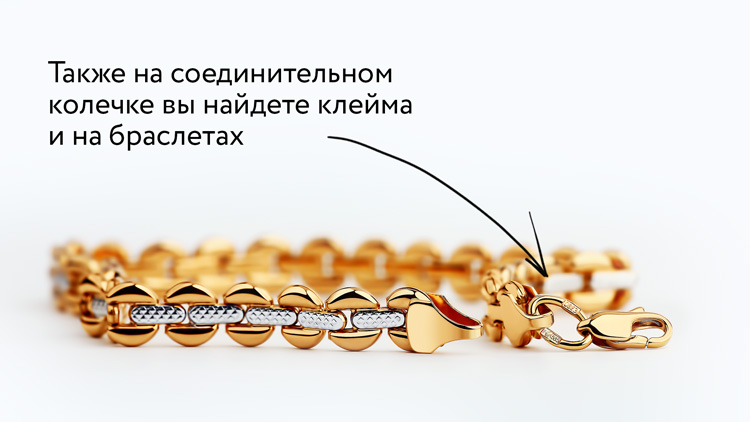
On different types of products prints are applied to different places. So, on the rings, you need to look for them on the inside or outside of the bob. On the earrings the mark is most often placed on a pin or a bolt. On the mark applied to the suspension rings. If you buy a bracelet, the print should be sought on the ring or link connecting the main part of the product and the lock. Manufacturers strive to apply stigma so that their presence does not affect the appearance of the jewelry.
Depending on the technology prints can be of different types. The most common - embossed - it is not always possible to use for particularly thin jewelry. In this case, a spark print is applied, in which even the most minimal deformation can be avoided.
Do your jewelry have all the necessary stamps?
Jewelry - the acquisition is desirable, but also exciting. It is necessary to prepare especially carefully, arm yourself with knowledge and go to a trustworthy store to avoid meeting with fakes. The author's impression will help in such a responsible matter - a stamp confirming the authenticity.
Today, the mark, in addition to the author's mark, is more often an impression of the state inspection, confirming the legality of the sale of the product and the content of the pure precious metal. By the way, the now known 925 standard silver standard was once introduced into circulation by the Tiffany jewelry house. Over the years, used variants of the sample mark, which can be used to determine in which country the jeweler worked and what is the composition of the product. For example, a stamp depicting a horse’s head indicates a 750th sample and sends us to France between 1838 and 1919. And the dog's head, the platinum pointer, appeared on the back of the jewelry later - it began to be widely used since 1912. The star, the hammer and sickle, the girl in the headdress are signs of Soviet-Russian times. Separately, it is worth paying attention when buying jewelry to the “name list” - some kind of encryption, in which the production year and the master code are actually hidden.
Let the team of the Faberge company consist in the best years of more than 500 craftsmen, in detail (from packaging to precious stones) working through each piece of jewelry, Carl Faberge kept all orders under control. Although historians have no evidence whether he ever created personally jewelery delights. But the mark of Carl Faberge exactly was. And in several versions - Petersburg and Moscow. Items created in the northern capital, had the mark of "Faberge", written in Cyrillic and without initials. Moscow production stamped "K. Faberge, complementing it with a double-headed eagle. Items intended for sale in Europe, branded in Latin. Masters who worked in St. Petersburg had their own stamps at their disposal, sometimes replacing the mark of the master. Occasionally, the products were left unmarked. The reason is simple - there is no space on the product or its special fragility.
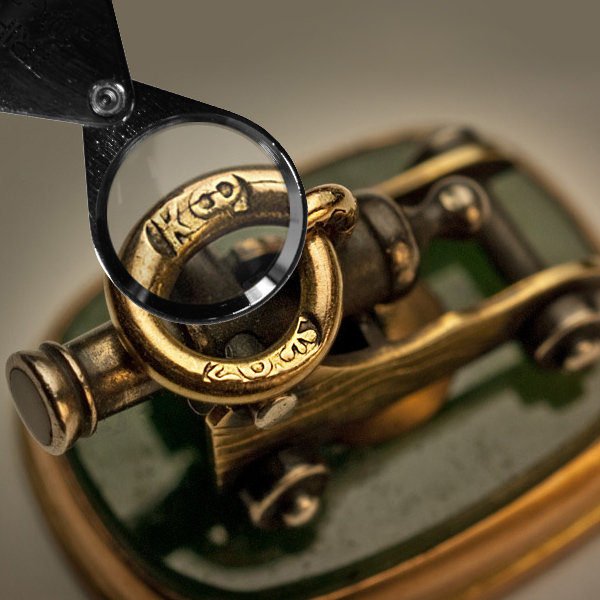
The history of the Van Cleef & Arpels jewelry house is not started from the official date - opening a boutique in house 22 on the Place Vendome and registering the brand, but registering a marriage between diamond cutter Alfred Van Cleef and Estelle Arpels, daughter of a gemstone dealer. For accuracy and completeness of the picture we will call both dates: the wedding was played in 1896, and the jewelry store opened 10 years later, that is, in 1906. But there is another year that keeps the memory of an important event for the brand - 1938th! It was this year that the mark of Van Cleef & Arpels was officially registered - a diamond with a Vendome column.

By the way, in addition to their own brand, jewelers often put an inventory number on their products. For example, the masters of the jewelry brand Carrera y Carrera, creating, among other things, jewelery for the Spanish royal family, enumerate all the items. What is not so difficult if you remember about the limited editions of products of this brand.
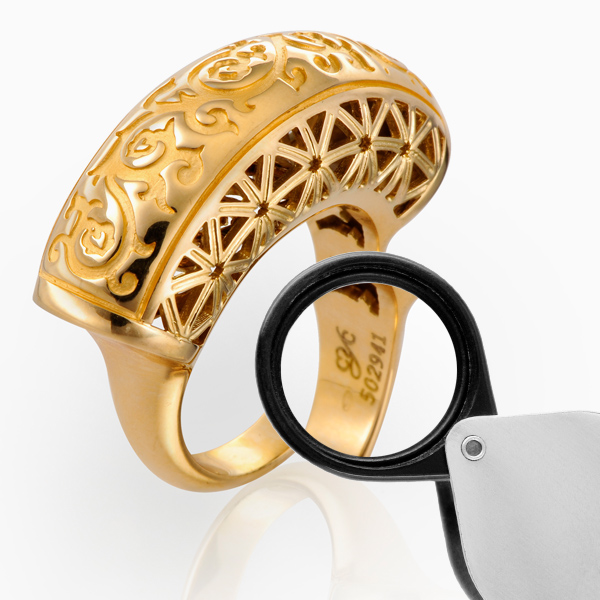
And representatives of Chopard advise anyone who has stopped in doubts about the authenticity of the watches purchased, not to waste time reviewing the details and studying the certificates, but to urgently call the brand’s employees. The inventory number engraved on the clock will help you quickly get a definite answer. Chaumet experts also provide services to customers of the brand, but primarily in determining the authenticity of products created prior to the introduction of the brand. Since the company’s employees carefully keep the archive, they organized a brand’s museum on the Place Vendôme, which presents sketches of products from the 18th century, the issue is resolved rather quickly - in the event of a positive response, the jewelery owner receives a certificate of authenticity.

The Graff jewelry house, founded in contrast to the brands already mentioned above not so long ago, or rather in 1966, nevertheless firmly holds one of the leading positions in diamond-gold issues. A distinctive feature of jewelry, issued under the brand Graff, was the identification number affixed by the masters of the company on each diamond, noticeable only with a multiple increase.
March 3, 2016
The stamp can consist of many different parts, indicate the most different procedures and movements that this subject was subjected to. But surely it will tell us about the country, the period and the quality of the metal.
Using the stamps of some countries as an example, we will see how much information can be conveyed by inconspicuous details.
To begin with, we divide the brand into several components:
This division is rather conditional. As you will see, each country has its own differences.
Invariably on all products one thing is the sample. The sample tells you how much gold or silver is contained in a certain amount of metal. It is important to know about how much precious metal in question and how much mass.
We consider the metric, carat, spool and lot systems of samples. The first two are most common in the world, the latter are of historical value for us, and I will also return to them in the course of the story.
Metric - We know the most and familiar. It shows how many particles of silver, or gold, are per 1000 metal particles. 925, 875, 575, 333 samples - they all relate to the metric system. The greater the value - the more noble metal in the product. Often, the values of metric samples were obtained as a result of recalculation of the carat sample, because it is older.
Carat The sample is based on the unit of mass measurement - carats. One carat is equal to 0.2 grams. The word carato in translation from Italian means - "seed of the carob tree." These grains have long been used to designate mass, as they are stable in weight. Carats are denoted as follows: K, kt, C, ct. This sample system applies only to gold. It shows how much a carat of gold accounts for 24 carats of the total mass (per 4.8 grams). There are the following tests and they correspond to the samples of the metric system: 9 to - 375, 12 to - 500, 14 - 585, 18 to - 750, 21 to - 875, 22 to - 916, 23 to - 958, 24 to - 999.
Zolotnikova the sample is tied to the Russian pound, which was 96 spools. One spool is 4.266 g. Shows how much precious metal is contained in one pound. Spool test and its conformity in the metric system: 3 6 h - 375, 48 h - 500, 56 h - 583, 72 h - 750, 84 h - 875, 88 h - 916, 91 h - 947, 92 h - 958, 96 h - 999.
Lot the sample operated in Germany in the Middle Ages until 1888. The basis of this system is one brand, which equals 16 lots. The sample itself shows how many lots of gold or silver are in one brand. One lot, in turn, contains 12.797 g. There are such samples: 6, 8, 12, 14, 16 .
Samples as a whole are fairly unified. Knowing the basic trial systems, you can already say something about the product. The remaining components of the stigma differ in different countries. We will analyze stamps in Germany, France, England, Ukraine and the USSR.
It all started back in the Middle Ages, when a craft organization of craftsmanship was established in Germany. The jewelers were united in the workshops, and this organization helped them solve various difficulties and manage their production affairs. They established a hierarchy of three levels: master, journeyman, student. The oldest mention of the stigma in Germany dates back to 1289. From that moment on, the development of a stamp system began. The system is not only a designation on the product, but also tax laws, guilds, and assay fees. European countries followed the path of creating a system synchronously, there were no ready-to-follow role models, so the process was delayed.
Only in 1548 in Germany it was officially established - to brand all items made of precious metals weighing over 4 lots (51 grams). It consisted of a lottery test, the stamp of the master and the stamp of the elector. Also, added the designation of the city and the year. The stamp of the Elector was a confirmation that the item was actually tested and has exactly the amount of the precious metal that is stated in the sample. By 1667, the sample was finally consolidated - the “Cologne mark”, it was equal to approximately 800 silver samples. In 1888, the lot sampling system was replaced by a metric one. The state standard of branding became the following: the mark of the master, or of the company, and the sample and state confirmation of the authenticity of the sample were designated - a month with a crown.
To this day, if you see a product with 800 silver, it is most likely from Germany.
The first mention of stamps on precious metals in France dates back to 1272. It was about the stamp of the city and the master, which used to look like a pictogram: a cross, a flower, a heart. Already in 1378, the state standard of silver was officially approved (gold was inaccessible to the broad masses of the population, only for the church and the nobility). But the masters did not want to brand products, in the provinces it was impossible to control them. The procedure was not yet ready for use and disappeared.
But the desire of the state apparatus to control the movement and use of precious metals has very good reasons. War trophies circulated freely and the amount of imported metal was unknown. It became all the more relevant control and accounting of precious metals, from which it was possible to withdraw the tax and replenish the treasury. And with the development of the royal court increased the need for money. The imposition of taxes on jewelry makers was a partial solution to the problem.
In 1672, a stamp was introduced to certify that the tax was paid, which was put down by a special person - the farmer. There was also an inventory stamp that was put if the farmer left the post early. Mandatory were the mark of the master, the state stamp, or city, the stamp on the payment of tax and exemption from taxes. In Paris, an annual stamp letter was added to this set, as well as a special procedure for the control of large items. The process consisted in the fact that the master put a nominal on all the fragments of the product, tested them in the Guild, paid all taxes, (at each stage there was a stamp), and after assembling, paid taxes again, which certified the corresponding stamp. And only then the master could sell the product. This incredible procedure significantly raised the cost and slowed down the production as a whole.
After the French Revolution, the vice of taxes and assay control weakened, but all warranty and tax stamps soon returned. Since the beginning of the 19th century, the stigma has become more unified. The head of Hermes certified the state control, the letter indicated the date and the test was made. Significant complications in marking and probing were no more.
However, as a whole, all these bureaucratic entanglements, apparently, partly led to the fact that today French products are not as common as English or German ones with age.
At the same time, as in France and Germany, in England there is a problem of controlling the quality of metals. At the beginning of the 13th century, a jewelers' guild was created in London. The most reputable masters walked around the shops and checked samples on the products of their colleagues. Later, there was a need for a separate building, which the city allocated to them. Therefore, in England there is the word - “hallmark” (hall in translation - the hall, mark in translation - a stamp), which is associated with this building, where the products were checked. In 1363, it was decided that each master should have his own name and put it only after checking with the guild and the presence of the corresponding stamp.
By the middle of the 15th century, the following problem arose: there was a lot of low-grade silver in the country, and the high-quality metal tested by the state was exported. Therefore, in 1477 it was decided that all items produced in the province should be brought and inspected in London. And put the date - the letter in the cartouche that marked the year. Since 1701, they began to open assay facilities throughout the country, which made it easier to control and account. In the 19th century, there were five stamps on the products: the state stamp that certified the sample, the annual stamp, the city stamp, the craftsman, and the payment of taxes. A separate stamp was put on imported products.
To this day, out of the five stamps, 4 are left (all but the stamp on paying taxes have been preserved). Each city has its own designation - an icon, each year has its own letter with a specific font. In general, this is a very clear and informative scheme for marking products.
Thus, we see that stamps on products tell us first of all about the relationship of jewelers with the state, officials and taxes. This is a whole story, told with the help of metonymy - in a small stigma we see big events, wars, triumphs, revolutions.
As in Europe, in Ukraine, the main form of organization of artisans was a workshop. A document has been preserved according to which we know that in 1518 there existed a shop of goldars in Kiev. The golden coins were called as masters who worked with silver, and with gold. Also, guilds existed in Pryluky, Chernigov, Ostrog, Nezhin, etc. We have reached some of the jeweler's stamps, their banners and statutes. The shop hierarchy provided for the obligatory presence of a statute that prescribed under what conditions a student could become an apprentice, and an apprentice could become a master. The master himself stamped both his products and apprentices' products. In some cases, the stamp could belong to the donor-customer. These circumstances greatly complicate the attribution of products.
The earliest stigmas on the territory of Ukraine, known to us, date back to the 16th century. It is known that in 1599 all jewelers in the city of Lviv were obliged to stigmatize their products so that they would not fall into the hands of buyers. There is a mark of 1547 on a silver cross, which is located in the Kiev Historical Museum. From the 16-17th century there are products from other parts of Ukraine, where they put their name, nickname, or initials.
In the 17th century, masters of Kiev began to put on their products Kiov. Later, all cities had assay chambers and put their stamps that were tied to the emblem of the city. Interestingly, the probing system was originally carat, but from the 19th century they adopted the spool valve. At the same time, the standard of branding was the following: the spool sample of the product, the stamp of the city and the stamp of the master. The form of the stamp has changed, which helps us determine the age of the product. And since 1908, a mark of a national certificate has been added to the assay mark - a female head in a kokoshnik.
All this tells us about a rather chaotic situation. It was significantly influenced by the absence of a unified state apparatus for a long time. This saved the masters from having to test their products and pay taxes. Of course, it also gives us less information about a particular product, about the intensity of exchange, trade in these products, complicates the dating.
After 1991, the trident became the state stamp of Ukraine. To date, there are 13 state assay chambers (they put down a trident) and 4 mansion plants. These are Vinnitsa, Kharkov, Lviv and Kiev jewelry factories. They can perform the assay control themselves and do not set a trident, but a chestnut leaf.
From 1917 to 1927, the standard of stigma in the territory of Soviet power was absent. Only 10 years after the revolution in the USSR was the state stigma accepted - head worker. There was also a transition from the spool-based sampling system to the metric one, which at that time was used in Europe. The head with the hammer at the ready + the letter code of the assay inspection (at first it was a letter of the Greek alphabet) became the hallmark of the assay chamber. The stamp was either in the form of a scapula, or in the form of a quadrangle with convex opposite sides (since 1956). For silver - 875, for gold 583.
From May 8, 1958, the worker’s head was replaced with a five-pointed star with a sickle and a hammer inside. At the same time, assay inspections began to be denoted by the letters of the Cyrillic alphabet.
The names of the factories appeared in 1936, often they were abbreviations of names. And since 1953, at the end they began to add a figure that marked the year. Thus, if the stamp with the head of a worker, and the name plate looks like this: “СЮ6”, this means that the product was made in 1956. But if there is a star on the assay mark, then the same nominal will stand for 1966. From 1969 to 1978, the exact production date was indicated by adding the last digit of the year to the beginning of the nominal. For example, the name “0ХЮ” tells us about 1970.
Jewelry made from precious metals and stones and intended for trade, in accordance with the requirements of the laws of Russia, are marked with the assay stamp and the name of the factory or factory of the manufacturer.
Applying the assay mark is the prerogative of the state assay inspection - the executive body that is authorized to implement the functions of assay supervision. In other words, the assay mark is a peculiar quality mark and a guarantee of conformity certified by the state.
The assay mark has a structure that includes several integral elements:
1 - Code of state inspection of assay supervision
2 - Assay ID Badge
3 - Digital designation of precious metal samples
These elements are put down by one image or are put independently from each other.
Assay inspector ciphers are denoted by large letters of the Russian alphabet. For example, "A" - North, "M" - Central. In total, there are 18 territorial assay bodies in Russia. Thus, for each assay inspection has its own letter. Every year the letter changes.
There are two most common signs of a test certificate on the territory of the Russian Federation. The first is an image of crossed sickle and hammer inscribed in a five-pointed star. Such a symbol has its history since 1958. Today it is practically not used, though not prohibited by law. The second is the image of the right profile of the female head in a traditional headdress - kokoshnik. This symbol was approved in Russia in 1994 and today it is most prevalent.
The birthday list is a special sign of the manufacturer’s enterprise applied to jewelry.

1 - code of the year
2 - the code of the State Inspectorate Assay Supervision, in the area of activity of which the manufacturer is located
3 - manufacturer's cipher
Name names appeared in the Soviet Union and at first were one. Since 1936, every enterprise producing jewelery has received its own unique nominal.
From 01/01/2000, the nominal list of any manufacturer in our country is determined by a unified formula. This is a special alphanumeric designation. It contains certain information:
The set of symbols of the nominal is in a special contour.
The name of each manufacturer's plant is subject to mandatory registration and approval. According to the norms of existing laws and regulations, this duty is assigned to the assay chambers in accordance with territorial subordination. This is the usual procedure. At the same time, the nominal of the enterprise can be approved and registered by any assay chamber, regardless of its location.
For the initial registration of the nominal, as well as for its annual re-registration, an established state fee is charged.
The factory or the plant may be denied re-registration of the nominal. This is most often associated with poor-quality technical requirements when submitting the necessary documents and other materials to the appropriate assay chamber.
The name list is affixed to the inner side, invisible to the eye, or to the element of the jewelry's lock. This is done in order not to spoil the "commercial" type of jewelry. Looking at a specific nominal, a specialist will be able to determine exactly by whom and when this jewel is released.
Today, all legal relations in the field of labeling, branding and jewelry probing are regulated by three regulatory acts:
Federal Law of the Russian Federation dated March 26, 1998 No. 41-ФЗ “On Precious Metals and Precious Stones” current version dated May 02, 2015;
Resolution of the Government of the Russian Federation dated 1/19/1998 N 55;
Government Decree of 06.06.1999 N 643 "On the procedure for testing and stamping products made of precious metals."
These regulatory and legal acts declare precise definitions and procedures for carrying out activities on the branding and probing of jewelry.
When a buyer purchases gold jewelry, he should definitely double-check the existence of the elements described above, confirming their quality and legitimacy of production. Name-plate and assay mark must have correct geometric outlines and be readable. Special care and attention should be observed when purchasing foreign jewelry made outside of the territory of Russia. If you ignore this simple rule, then there is a great risk of becoming a victim of fraudsters and instead of a real jewel to become the owner of a brilliant trinkets.
| Related articles: | |
|
Jewelry Branding
Porcelain marking was used almost from the very beginning ... Crochet cover pattern
Size: 120 x 170 cm. You will need: Novita Miami yarn (50% cotton, ... A selection of schemes for knitting double-sided scarves
A handmade scarf is always relevant. Knitting a scarf with knitting ... | |